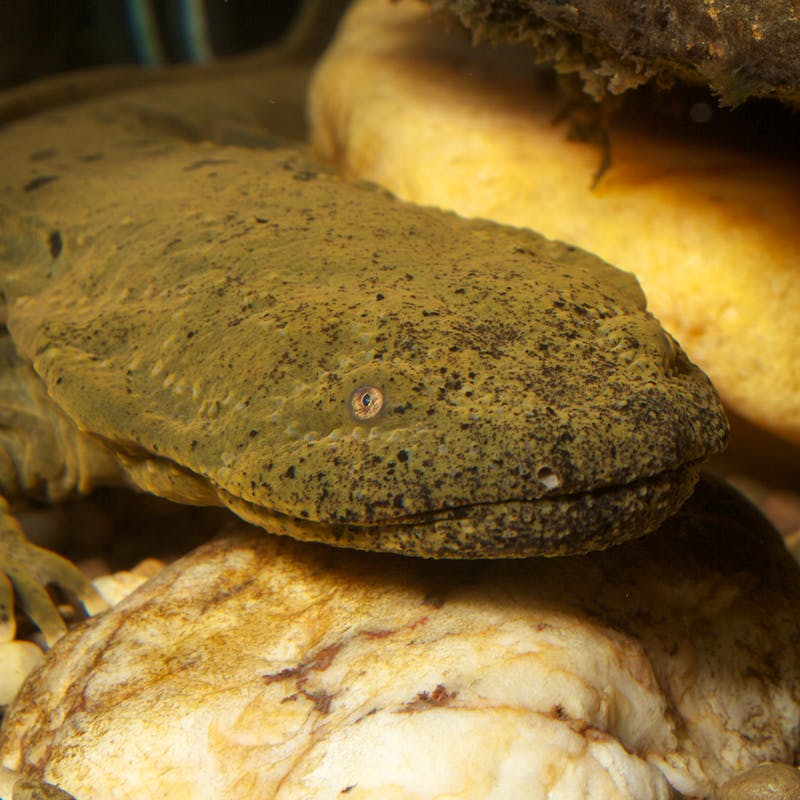Media Contacts: Jeff Holmes, Amphibian and Reptile Conservancy, jholmes@amphibiansreptiles.org
Jake Bleich, Defenders of Wildlife, jbleich@defenders.org, 202-772-3208
The Amphibian and Reptile Conservancy (ARC) has received a $100,000 grant from the National Fish and Wildlife Foundation (NFWF) that will be used for programs that help conserve and protect the eastern hellbender salamander. ARC and conservation partner Defenders of Wildlife contributed $50,000 each in matching funds for a total conservation impact of $200,000. The funding—part of the NFWF’s Cumberland Plateau Stewardship Fund--will restore and enhance riparian forest habitat buffers and implement additional conservation practices on private farmland in Tennessee's Cumberland Plateau.
"More than two-thirds of the forests across the Cumberland Plateau are owned by families and individuals, making them crucial players in helping ensure a healthy habitat for wildlife. The project will restore at least seven acres of riparian habitat through tree plantings, livestock exclusion fencing, and streambank stabilization on these private lands," said Jeff Holmes, Executive Director of the Amphibian and Reptile Conservancy.
The grant funds will support the implementation of the Southeastern Hellbender Conservation Initiative (SEHCI), a partner-driven collaboration focused on restoring and conserving hellbender habitat on privately owned lands in the Southeast. Through this initiative, ARC and Defenders, together with their partners in the U.S. Department of Agriculture’s Natural Resources Conservation Service and the U.S. Fish and Wildlife Service work directly with landowners to provide technical assistance and financial incentives for adopting management practices that restore and protect hellbender habitat.
“The conservation practices supported by this grant will improve soil stability and livestock safety, so it creates a win-win outcome for both landowners and hellbenders,” said Kat Diersen, Defenders of Wildlife Southeast Representative.
Referred to by locals as mud devil, ground puppy, and snot otter, the hellbender is a unique amphibian that has a colorful place in local legend across the Cumberland Plateau. Contrary to some myths that they are poisonous or that their slime can harm fish and other stream creatures, hellbenders are actually harmless to people. They also have the unusual ability to breathe through their skin. This makes them very sensitive to changes in water quality, making them an important indicator species for overall stream health.
In the late 1950s, researchers learned that the hellbender's range was decreasing rapidly as a result of modifications to stream habitats. Among the threats to stream habitats are the accumulation of silt and agricultural and industrial pollution.
"Through the Cumberland Plateau Stewardship Fund, government agencies and private corporations are working together to restore native forests and enhance freshwater systems for an array of colorful and rare species, like the eastern hellbender," said Jeff Trandahl, executive director and CEO of the National Fish and Wildlife Foundation.
This funding awarded to the Amphibian and Reptile Conservancy is part of a suite of grants that will generate $1.3 million in matching contributions for a total conservation impact of $2.6 million. Since 2013, the Cumberland Plateau Stewardship Fund has invested more than $6 million in projects that will establish, enhance, and protect more than 100,000 acres of shortleaf pine and riparian forests, as well as improve 564 miles of stream habitat, to benefit the birds and wildlife that rely on these ecosystems.
The Cumberland Plateau Stewardship Fund is a public-private partnership. Major funding for the Cumberland Plateau Stewardship Fund Grant Program is provided by Altria Group, American Forest Foundation, International Paper's Forestland Stewards Partnership, U.S. Fish and Wildlife Service and USDA Natural Resources Conservation Service.
###
About the Cumberland Plateau Stewardship Fund
The Cumberland Plateau Stewardship Fund was established in 2013 to restore forest and freshwater habitats to conditions that will improve associated wildlife species and the health of freshwater systems while advancing strategies to support working forests. The Fund is a public-private partnership, with federal funding provided by the U.S. Fish and Wildlife Service and USDA's Forest Service and Natural Resources Conservation Service, and private funding from International Paper's Forestland Stewards Partnership, Altria Group, Alcoa Foundation, and the American Forest Foundation's Southern Woods for At-Risk Wildlife Partnership. Learn more: nfwf.org/cumberland
About the Amphibian and Reptile Conservancy
The Amphibian and Reptile Conservancy (ARC) is dedicated to the conservation of herpetofauna and their habitats. As a 501(c)(3) not-for-profit organization, ARC conducts a wide variety of activities to create, restore, improve, and conserve amphibian and reptile habitats in the United States. These activities include surveys, monitoring, habitat management, training, education, fundraising, advocacy, and facilitating collaborative projects that promote amphibian and reptile conservation across public and private landscapes. Learn more: amphibianandreptileconservancy.org
About the National Fish and Wildlife Foundation
Chartered by Congress in 1984, the National Fish and Wildlife Foundation (NFWF) protects and restores the nation's fish, wildlife, plants, and habitats. Working with federal, corporate, and individual partners, NFWF has funded more than 4,500 organizations and generated a conservation impact of more than $5.3 billion. Learn more at www.nfwf.org.
For over 75 years, Defenders of Wildlife has remained dedicated to protecting all native animals and plants in their natural communities. With a nationwide network of nearly 2.1 million members and activists, Defenders of Wildlife is a leading advocate for innovative solutions to safeguard our wildlife for generations to come. To learn more, please visit https://defenders.org/newsroom or follow us on X @Defenders.
Media Contact
News

Defenders, Conservationists Celebrate Female Mexican Gray Wolf Movement

